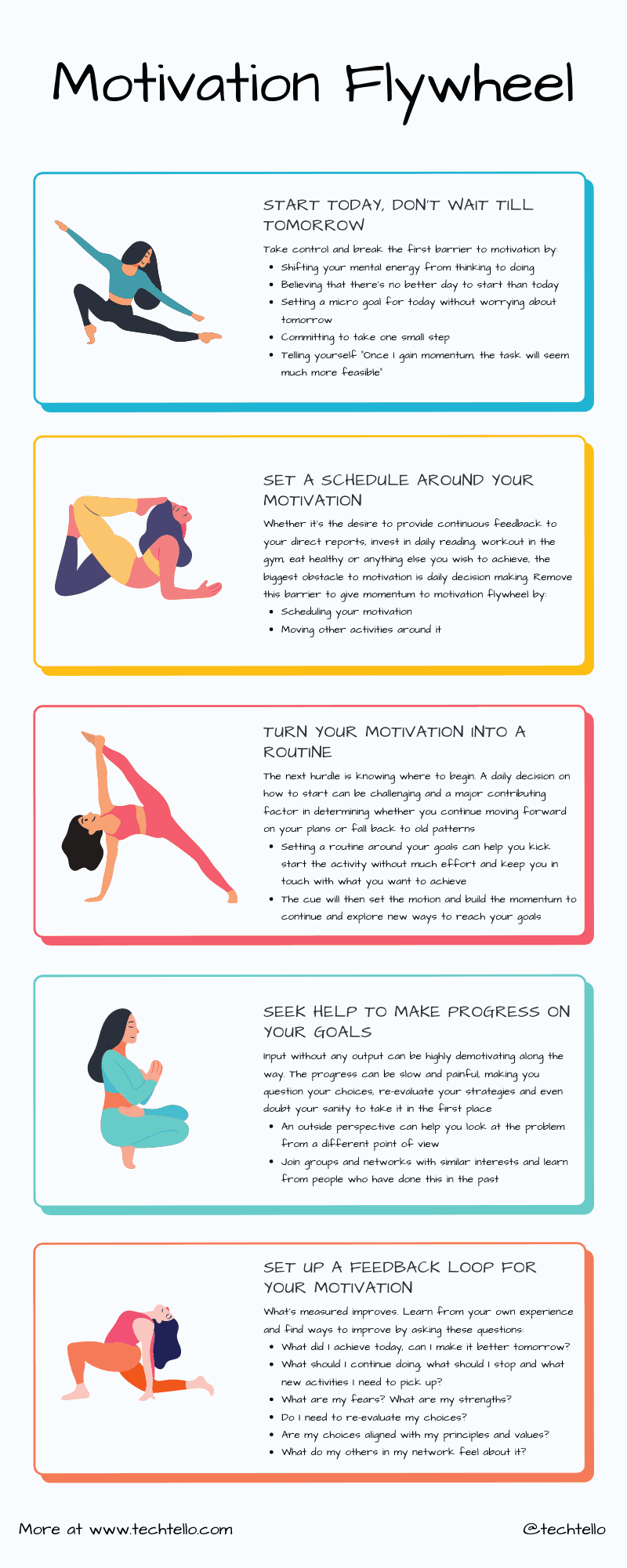Put Your Motivation Flywheel To Action

How can I make motivation part of my life to do things that will help me achieve my goals in the long run? For me, motivation was a state of mind. Some days I was all excited and motivated to get to my toughest goals and important tasks that I had avoided in the past. Then there were other times I felt lost, unsure of how to make even tiny progress on things I got to do.
I knew that none of our desires can be fulfilled without motivation – eating healthy, working out, sleeping better, reading more, being productive or anything else that we wish to achieve. We may make some progress in the short term but without motivation it won’t last long and we will soon go back to our old habits.
Yet, my mind was occupied with overthinking – thoughts about my past, tasks that I never started and objectives I did not achieve. It made me feel like a failure, not mustering enough courage to plan ahead and blamed it on lack of motivation.
I thought motivation is something that happens to us – I either have it or I don’t.
Like other human beings, I was completely irrational. I did not do what was in my best interest even though I wanted it badly. I rationalised my inaction as lack of motivation and attributed it to being too busy or too lazy to do things I should really be doing.
Then, I had this aha moment. I learnt that motivation doesn’t happen to us, it’s a muscle that we need to build. That simple truth completely changed my life. It’s what inspired me to design and set my own motivation flywheel in action.
Stephen R. Covey’s simple, yet highly valuable advice in The 7 Habits of Highly Effective People
How different our lives are when we really know what is deeply important to us, and, keeping that picture in mind, we manage ourselves each day to be and to do what really matters most
Motivation is not thoughts, it’s the action that drives it

We go to bed feeling motivated after watching an inspirational talk, but the next morning we are back to the same routine with the same old habits.
Why does this happen?
It’s because the inspiration from the talk releases dopamine in our brains that makes us feel good in the moment but once the moment has passed, we do not make an effort to act.
Reading a great book, a blog post, watching a video, listening to podcasts are all prominent things to set our thinking in motion. But by themselves, they do not help us achieve anything.
Lack of motivation is not lack of information, it’s the lack of behaviour to put that knowledge to use.
Only the act itself can set motivation flywheel in action. It’s the tiny step in the direction of our goals, crossing the first hurdle, making an effort to break the mental barrier and not give in to our fears.
It’s asking “How can I make today better than yesterday and tomorrow better than today?”
James Clear on motivation in Atomic Habits
Many people think they lack motivation when what they really lack is clarity. It is not always obvious when and where to take action. Some people spend their entire lives waiting for the time to be right to make an improvement.
How does motivation help us

Tasks are always daunting in the beginning and even tiny little progress demands a lot of motivation.
The positive change resulting from our effort is so minor in the beginning that we fail to notice it. It may seem like we are standing where we started and it’s often easy to give up. But, it’s exactly at this point that we need to keep pushing forward.
With practice and repetition, our brain adapts to new information, creates patterns of learning and switches to autopilot. Tasks that once demanded a lot of effort and motivation soon become trivial. Once our mind aligns with our new routines, it helps us push our own limits instead of fighting back.
The mental source of energy that comes from taking action turns impossible to possible. We do not fear failure anymore once we learn to find pleasure in trying.
Motivation moves us from procrastination to action, pain to gain, gap to learning, shackles to freedom and imagination to reality. It’s what turns our desires to habits and sets the flywheel in action.
Techniques to set motivation flywheel in action
It may be wonderful to visualise the end state without dealing with the setbacks along the way. However, learning what can pull you back is as important as determining how to get started.
Some of the important questions to answer while learning how to get motivated and take action are:
- What are the bottlenecks to get me started?
- What can cause me to stop once I start?
- How do I know what to do once I get started?
- What if I am not capable of achieving it?
- How do I know if I am making progress?
Follow these techniques to remove the barrier to getting started, build the rhythm and improve as you move along:
1. Start today, don’t wait till tomorrow
Do not wait for the motivation to kick in to get started. Remember motivation is in action and not waiting for some bells to ring in your ears, some inner voice that will tell you “today is a good day; now is a good time”.
Even if you don’t feel like it, which is by the way the most common excuse we give ourselves, nothing will change today that will bring in the extra motivation tomorrow. Today is as good as tomorrow.
Take control and break the first barrier to motivation by:
- Shifting your mental energy from thinking to doing
- Believing that there’s no better day to start than today
- Setting a micro goal for today without worrying about tomorrow
- Committing to take one small step
- Telling yourself “Once I gain momentum, the task will seem much more feasible”
Initiate your motivation flywheel today and just feel the difference.
2. Set a schedule around your motivation
Early in my engineering career, I picked up salsa dancing and started training at a dance academy. I was always fascinated with dance but there was something about the salsa moves that got me enchanted.
My love for this new form of dance grew as much as my passion for coding and building products. At the same time, my responsibilities started expanding and it became extremely difficult to continue the classes.
Even though I had to attend classes only 3 days a week, I ended up postponing each day while lying to myself “I will finish this work today and definitely make it to the class tomorrow”.
As I continued missing my classes and practice, I felt terrible. It impacted me emotionally but I didn’t do anything to fix the situation.
Then one Saturday morning, I thought about the problem. Instead of asking “How can I continue to attend the classes?”, I applied inversion to my thinking and questioned “What prevents me from attending them?”
I realised that the biggest obstacle to motivation was making the daily decision – finishing up the work or making it to the class?
So, I decided to block 3 days of the week for my classes and moved all my other activities around it. Once on my calendar, I removed a barrier to daily decision-making that enabled me to achieve my personal as well as professional goals. I no longer had to make a decision, simply attend the class as the decision has been made.
A tiny step in the right direction (the simple act of scheduling it on my calendar) kicked in the motivation and the schedule assisted me to stick to it. Interestingly, it also helped me get better at my job as I was able to spend more mental energy on my work and less dealing with the fear of missing my class again.
Whether it’s the desire to provide continuous feedback to your direct reports, invest in daily reading, workout in the gym, eat healthy or anything else you wish to achieve, the second step to give momentum to motivation flywheel is to schedule it.
Remember this from Stephen R. Covey, The 7 Habits of Highly Effective People “The key is not to prioritise what’s on your schedule, but to schedule your priorities”
3. Turn your motivation into a routine
Once we find the courage to act and set a schedule around our goals, the next hurdle is knowing where to begin.
A daily decision on how to start can be challenging and a major contributing factor in determining whether we continue moving forward on our plans or fall back to our old patterns.
Setting a routine around our goals can help us kick start the activity without much effort. Here are examples of some of the routines that I follow:
- For yoga, lay down the mat before waking up my daughter and then practice Surya Namaskar for the first 5 mins
- For my writing goal, set up my table with a bottle of water and read what I wrote the previous day
- For team feedback, read my notes from the previous discussions
- For reading, read the first two chapters of the next 3 books in my Goodreads “Want To Read” list and then pick one to start unless I am already reading something in which case just continue where I last left
Simple routines like these keep the motivation flywheel going by removing the barrier to getting started and bringing you in touch with what you want to achieve. The cue then sets the motion and builds the momentum to continue and explore new ways to reach your goals.
4. Seek help to make progress on your goals
Trying to achieve something which is not in our area of competence and hence too difficult for us can be scary.
Input without any output can be highly demotivating along the way. The progress can be slow and painful, making us question our choices, re-evaluate our strategies and even doubt our sanity to take it in the first place.
At times like these, an outside perspective can help us see beyond our own biases and look at the problem from a different point of view.
James Clear has great insights about it in Atomic Habits,
We think we need to change our results, but the results are not the problem. What we really need to change are the systems that cause those results. When you solve problems at the results level, you only solve them temporarily. In order to improve for good, you need to solve problems at the systems level. Fix the inputs and the outputs will fix themselves.
Reach out to friends, family, colleagues and share where you stand in the moment, what you desire and seek advice on how to move forward. Even join groups and networks with similar interests and learn from people who have done this in the past.
You don’t have to follow every piece of advice that comes your way, but the information will be valuable enough for you to make an informed decision on how to move ahead. It will prevent the motivation flywheel from being stuck by giving it an opportunity to learn from others.
5. Set up a feedback loop for your motivation
What’s measured improves. Learning from your own experience and finding ways to improve will set you on a path that is rewarding and fulfilling. Setting up a feedback loop for your motivation flywheel will keep it realistic and capable of improvements.
You may not have all the answers on day 1 or even day 10. But repeating these questions to yourself and spending time in deep inquiry will slowly give you the answers:
- What did I achieve today and how can I make it better tomorrow?
- What should I continue doing, what should I stop and what new activities I need to pick up?
- What are my fears?
- What are my strengths?
- Do my strategy and tactics work or do I need to re-evaluate my choices?
- Are my choices aligned with my principles and values?
- What do my close friends and family feel about it?
Once you start employing these practices in your daily life, you will notice a transformation in how you approach new goals. Instead of the initial resistance and procrastination, you will find yourself setting schedules and routines around your goals, being more open to seeking help and finding ways to improve.
Creating a schedule and routine around your motivation will slowly turn it into a habit, a way of doing things.
I hope this will inspire you to take that first step today. Don’t simply get inspired, act now to kick off your motivation flywheel. Did you do it? Write to me or share your thoughts in the comments below.






























